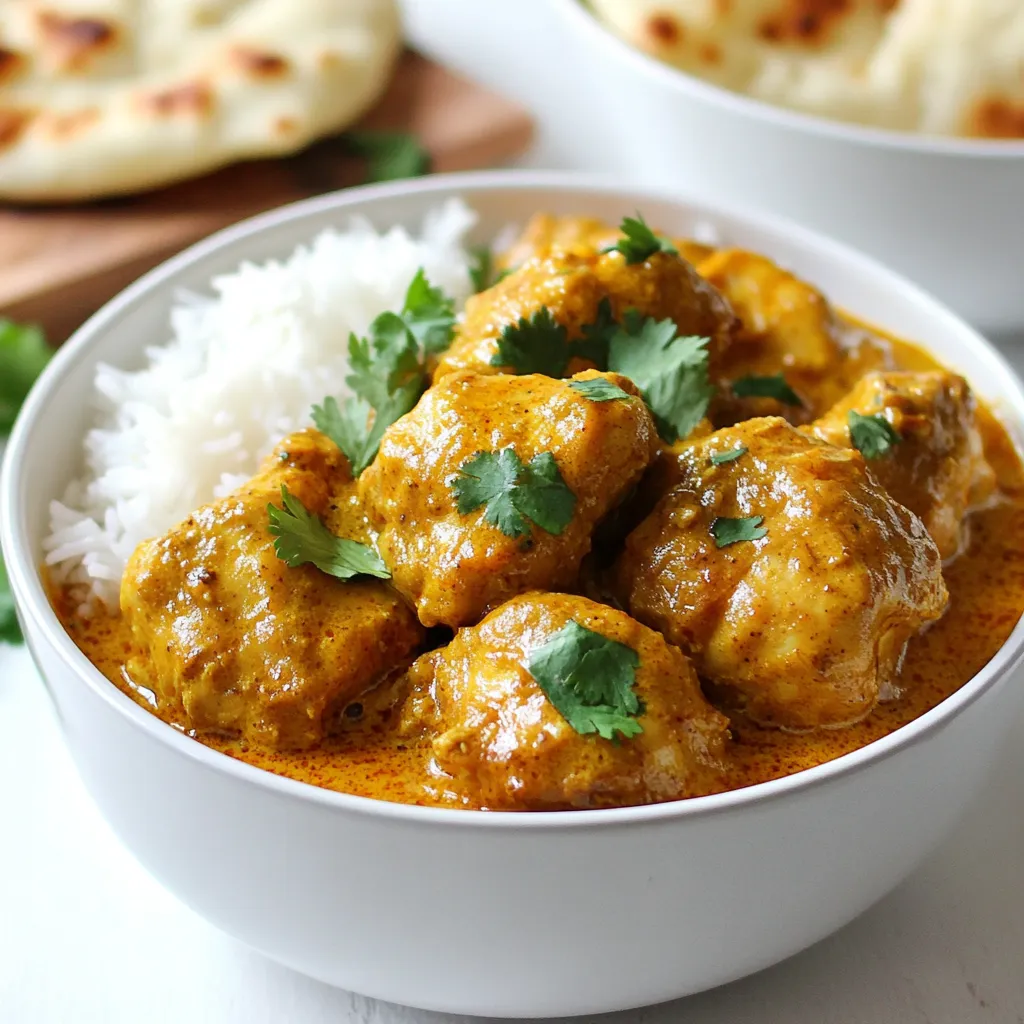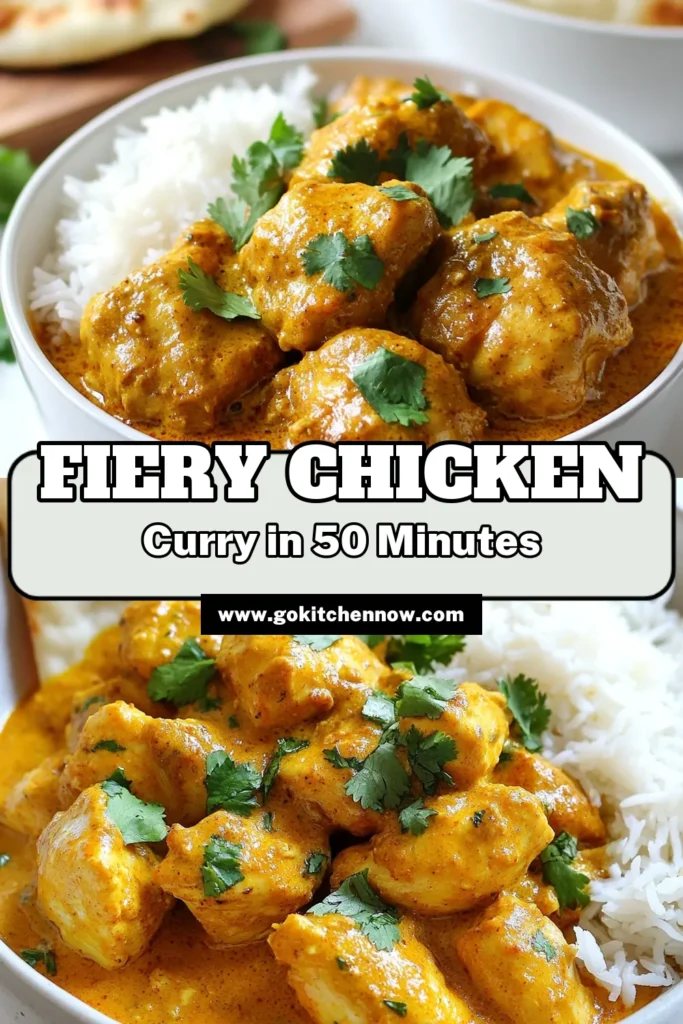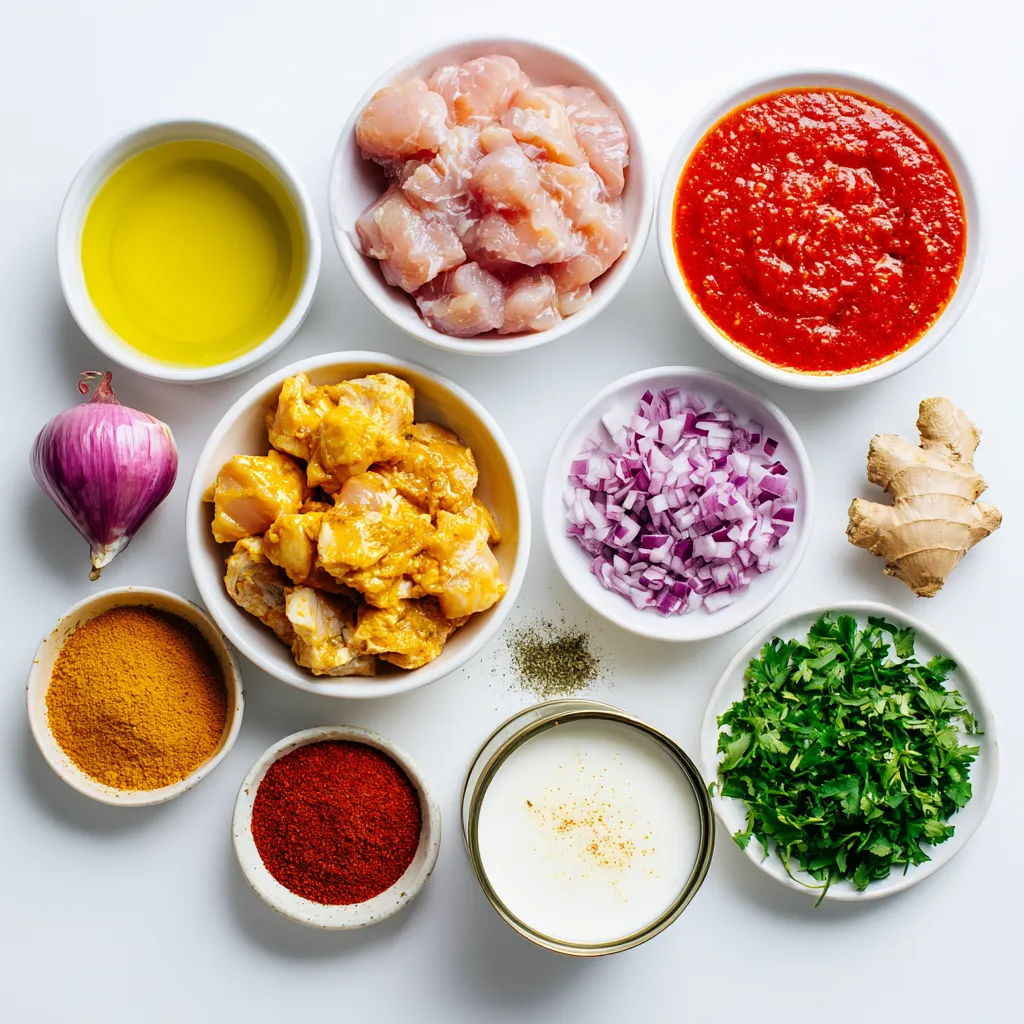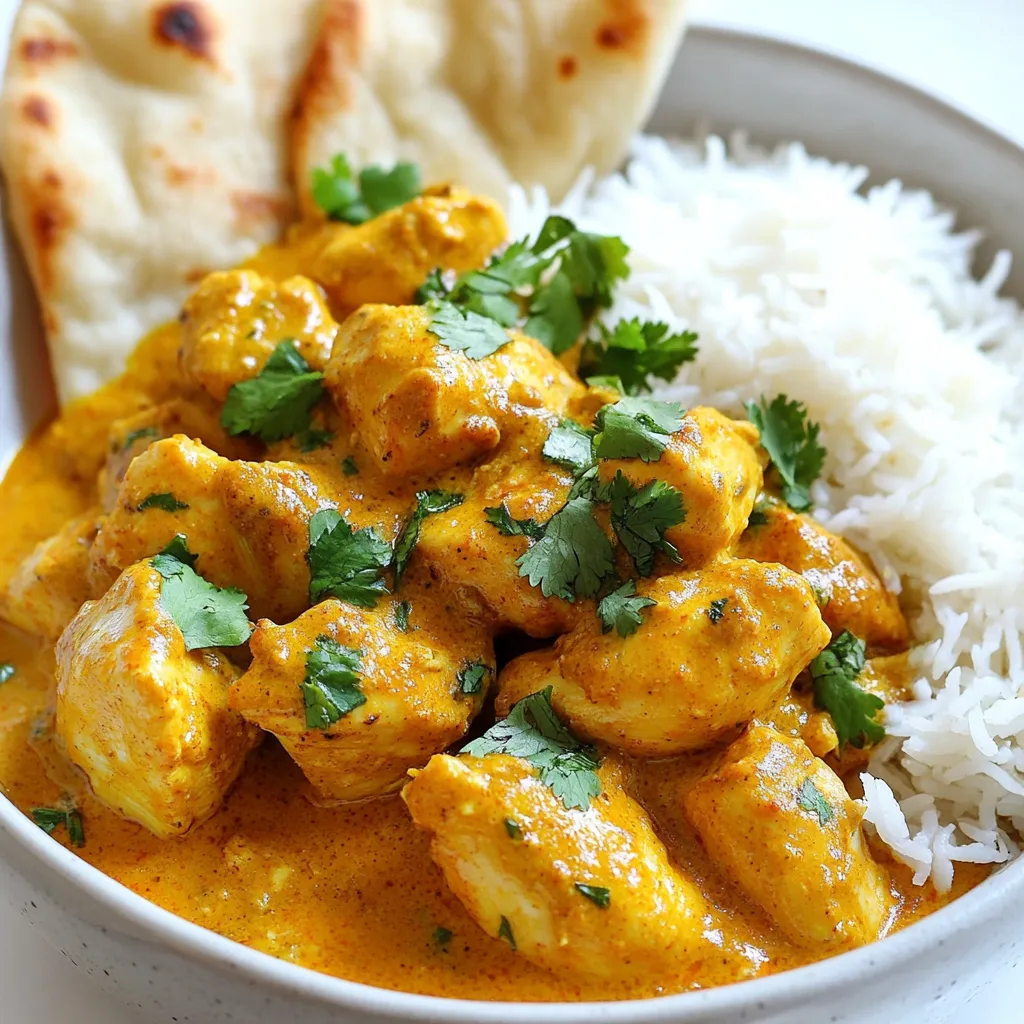WANT TO SAVE THIS RECIPE?
If you’re craving a dish that bursts with flavor but is easy to make, you’re in the right place! This Authentic Indian Chicken Curry recipe packs a punch with rich spices and creamy coconut milk. I’ll guide you through simple steps, tips, and variations to create your perfect curry. Let’s dive in and transform your kitchen into a delightful Indian spice hub! Get ready for a meal that’s both satisfying and delicious!

Why I Love This Recipe
- Bold Flavors: This curry is packed with a robust blend of spices, making each bite a delightful explosion of flavor.
- Comfort Food: Nothing beats a warm bowl of curry on a chilly day, and this recipe delivers that cozy, homestyle feel.
- Easy to Make: The straightforward preparation steps make it accessible for cooks of all skill levels.
- Versatile Pairing: This curry pairs wonderfully with rice or naan, allowing for a customizable dining experience.
Ingredients
List of Ingredients
– Chicken
– 1.5 lbs chicken thighs, boneless and skinless, cut into chunks
– Vegetables and Aromatics
– 1 large onion, finely chopped
– 4 cloves garlic, minced
– 1-inch piece ginger, grated
– 2 tomatoes, pureed
– Spices
– 2 teaspoons ground cumin
– 2 teaspoons ground coriander
– 1 teaspoon turmeric powder
– 1 teaspoon garam masala
– 1 teaspoon red chili powder (adjust to taste)
– Salt to taste
– Coconut Milk and Garnish
– 1 cup coconut milk
– Fresh cilantro, chopped (for garnish)
When I make this chicken curry, I focus on fresh ingredients. The chicken thighs are juicy and tender. They soak up all the rich flavors. I love using onions, garlic, and ginger for a strong base. Each adds depth to the dish.
Spices bring life to this recipe. Ground cumin and coriander give warmth and earthiness. Turmeric adds a bright color and a slight bitterness. Garam masala is the star with its sweet spice notes. The red chili powder can kick the heat up a notch or two, depending on your taste.
Coconut milk ties everything together. It adds creaminess and balances the spices. Fresh cilantro on top makes the dish pop. It adds a fresh taste and a nice color contrast.
With these ingredients, you’re ready to create a flavorful meal.

Step-by-Step Instructions
Preparation Steps
Sautéing the Onions
Start by heating the vegetable oil in a large pot over medium heat. Add the finely chopped onion. Cook it until it turns golden brown, which takes about 7 to 8 minutes. This step builds a sweet base for your curry and adds depth to the flavor.
Cooking the Aromatics
Next, stir in the minced garlic and grated ginger. Let them cook for another 2 minutes. You will smell a wonderful aroma as they cook. This mix of onion, garlic, and ginger adds great flavor to our curry.
Adding Tomatoes and Spices
Now, mix in the pureed tomatoes. Cook this mixture for about 5 minutes until it thickens. After that, add the ground cumin, coriander, turmeric, garam masala, red chili powder, and salt. Sauté this spice mix for 2 to 3 minutes. Toasting the spices helps release their flavors.
Chicken Cooking Process
Browning the Chicken
Increase the heat to medium-high. Add the chicken pieces to the pot. Cook for 5 to 7 minutes. Stir occasionally until the chicken is browned on all sides. This step locks in the juices and creates a nice crust on the chicken.
Simmering with Coconut Milk
Now, pour in the coconut milk and stir well. Bring the mixture to a simmer. After that, reduce the heat to low and cover the pot. Let it cook for 25 to 30 minutes, stirring occasionally. The chicken will become tender and soak up all the rich flavors from the sauce.
Final Touches
Garnishing and Serving Suggestions
Once the chicken curry is ready, taste it and adjust the seasoning if needed. Garnish with fresh cilantro before serving. For a beautiful presentation, serve the curry in a deep bowl. Pair it with fluffy basmati rice or warm naan bread. Add a slice of lime on the side for color and a zesty kick. Enjoy your flavorful meal!
Tips & Tricks
Achieving Authentic Flavors
Spice Toasting Techniques
To get the best flavor from your spices, toast them. Heat your pan first. Add the dry spices like cumin and coriander. Stir them for 2-3 minutes until they smell strong. This step wakes up the spices. It brings out their natural oils and flavors. You will notice a big taste difference in your chicken curry.
Importance of Fresh Ingredients
Always use fresh ingredients when you cook. Fresh onions, garlic, and spices make your dish shine. They add depth to your curry. A good tip is to buy whole spices and grind them yourself. This keeps their flavor strong and bold. Fresh coconut milk also enhances the dish. It brings creaminess and richness that canned versions can’t match.
Cooking Methods
Using Heavy-Bottomed Pots
Choose a heavy-bottomed pot for this recipe. It spreads heat evenly. This helps avoid burning your curry. A sturdy pot keeps everything simmering well. When you use the right pot, your chicken cooks evenly. It also keeps the sauce rich and thick.
Alternative Cooking Appliances
If you don’t have a heavy pot, you can use other appliances. A slow cooker or Instant Pot works well. They keep the flavors locked in and let the chicken cook slowly. This can make your chicken extra tender. Just adjust the cooking time for these devices. They can help you create delicious meals with less effort.
Serving Suggestions
Best Sides to Accompany Chicken Curry
Pair your chicken curry with the right sides. Basmati rice is a classic choice. Its fluffy texture balances the rich curry. You can also serve naan bread. It’s perfect for scooping up the sauce. If you want something lighter, try a simple salad. Fresh cucumber and tomato can brighten your meal.
Presentation Ideas
Make your chicken curry look appealing. Use a deep bowl to serve. Garnish with chopped cilantro for a fresh look. A slice of lime adds color and flavor. This makes your dish pop on the table. When you present well, it makes meals more special and inviting.
Pro Tips
- Adjust the Spice Level: Feel free to modify the amount of red chili powder based on your heat preference. Start with less and add more if you like it spicier.
- Marinate the Chicken: For deeper flavor, marinate the chicken in yogurt and spices for a few hours before cooking. This will also tenderize the meat.
- Use Fresh Ingredients: Fresh garlic, ginger, and herbs will elevate the flavor of your curry. Whenever possible, opt for fresh over dried ingredients.
- Rest Before Serving: Allow the curry to sit for a few minutes after cooking. This resting time lets the flavors meld together beautifully.

Variations
Regional Variations
Indian chicken curry varies greatly by region. In South India, the curry often has coconut milk. This gives it a creamy texture. You might find curry leaves and mustard seeds in the mix. These add a unique flavor that warms the heart.
In North India, you’ll see a richer sauce. This style uses yogurt for creaminess. Spices like cardamom and cloves give depth. You may also find it paired with naan instead of rice.
Dietary Modifications
If you want a vegetarian version, you can swap chicken for paneer or chickpeas. These options still give you protein and flavor. Use the same spices and cooking method. It will taste just as good!
For gluten-free needs, skip any bread and serve with rice. Most spices are naturally gluten-free. Always check labels for safety. Your meal can still be delicious and safe.
Heat Level Adjustments
Like spice? You can make it spicy by adding more chili powder. Start with one teaspoon and adjust to taste. For milder flavors, reduce the chili powder or use sweet paprika.
Different chili types add varied heat. For a smoky flavor, try smoked paprika. If you like sweetness, use bell peppers. Adjusting the heat makes the dish your own. Enjoying your meal is the goal!
Storage Info
Refrigeration Guidelines
How to Store Leftovers
After you enjoy your chicken curry, let it cool down. Use a clean, airtight container to store it. This keeps the flavors fresh and safe. You can also place it in smaller containers for easy meals later.
Shelf Life in the Fridge
Your leftover chicken curry stays good in the fridge for about 3 to 4 days. Make sure to check for any strange smells or changes in color before eating.
Freezing Instructions
Tips for Freezing Chicken Curry
If you want to keep your chicken curry longer, freezing is a great option. Allow the curry to cool completely. Then, pour it into freezer-safe bags or containers. Leave some space at the top for expanding.
Defrosting and Reheating Best Practices
To defrost, move the curry to the fridge overnight. You can also use the microwave for quick thawing. When reheating, warm it on the stove over low heat. Stir it well to make sure it heats evenly.
Meal Prep Ideas
Batch Cooking for Quick Meals
Cooking a big batch of chicken curry saves time. You can enjoy it on busy nights or when you need quick meals. Just store it in portions, and you’re set for the week.
Portion Control Tips
Use smaller containers for your meals. This helps you manage your portions and reduces food waste. You can grab a container and enjoy a tasty meal anytime.
FAQs
What is the difference between Indian curry and other curries?
Indian curry stands out for its rich spices and bold flavors. Other curries may use different spices or sauces. Indian curries often have a creamy base, like coconut milk or yogurt. They also feature a mix of spices, such as cumin and coriander. Each region in India has its unique style. For example, South Indian curry uses coconut and tamarind. North Indian curry tends to be richer and creamier. All these differences make Indian curries unique and exciting.
Can I use other types of meat for this recipe?
Yes, you can use other meats in this recipe. Lamb, beef, and shrimp can work well. Just adjust the cooking time based on the meat’s type. Fish cooks faster, so add it later in the process. You can also use tofu for a vegetarian option. Just remember to keep the spices the same for flavor. Each meat will add its own taste to the dish, making it versatile and fun.
What are some common side dishes for serving chicken curry?
Many side dishes pair well with chicken curry. Basmati rice is a classic choice. Its fluffy texture balances the rich curry. Naan bread is another favorite. It’s great for scooping up curry. You can also serve it with raita, a yogurt dip that cools the spice. A simple salad with cucumber and tomatoes adds freshness. These sides enhance the meal and provide a variety of flavors and textures.
This article explored the essential ingredients and steps for making a delicious chicken curry. You learned about key components, like fresh veggies, spices, and coconut milk, that create rich flavors. We discussed cooking tips to achieve authentic tastes, along with fun variations and serving ideas. Remember, cooking is a journey, and the right techniques make all the difference. With these tips, your chicken curry will shine at every meal. Enjoy experimenting and sharing the joy of food with others. Happy cookin
Spicy Indian Chicken Curry
A flavorful and spicy chicken curry made with aromatic spices and coconut milk.
Prep Time 15 minutes mins
Cook Time 35 minutes mins
Total Time 50 minutes mins
Course Main Course
Cuisine Indian
Servings 4
Calories 400 kcal
- 1.5 lbs chicken thighs, boneless and skinless, cut into chunks
- 2 tablespoons vegetable oil
- 1 large onion, finely chopped
- 4 cloves garlic, minced
- 1 inch piece ginger, grated
- 2 tomatoes pureed
- 1 cup coconut milk
- 2 teaspoons ground cumin
- 2 teaspoons ground coriander
- 1 teaspoon turmeric powder
- 1 teaspoon garam masala
- 1 teaspoon red chili powder (adjust to taste)
- to taste salt
- for garnish fresh cilantro, chopped
Heat the vegetable oil in a large heavy-bottomed pot over medium heat.
Add the finely chopped onion and sauté until golden brown, about 7-8 minutes.
Stir in the minced garlic and grated ginger, cooking for another 2 minutes until fragrant.
Mix in the pureed tomatoes and cook for about 5 minutes until the mixture thickens.
Add the ground cumin, coriander, turmeric, garam masala, red chili powder, and salt. Sauté for 2-3 minutes to toast the spices.
Increase the heat to medium-high and add the chicken pieces to the pot. Cook for 5-7 minutes, stirring occasionally until the chicken is browned on all sides.
Pour in the coconut milk and stir well. Bring to a simmer, then reduce the heat to low, cover, and let it cook for 25-30 minutes, stirring occasionally.
Once the chicken is tender and well-coated in the sauce, taste and adjust seasoning if necessary.
Garnish with fresh cilantro before serving.
Serve with basmati rice or naan bread. Garnish with cilantro and lime for added flavor.
Keyword chicken curry, coconut milk, Indian cuisine, spicy
WANT TO SAVE THIS RECIPE?





